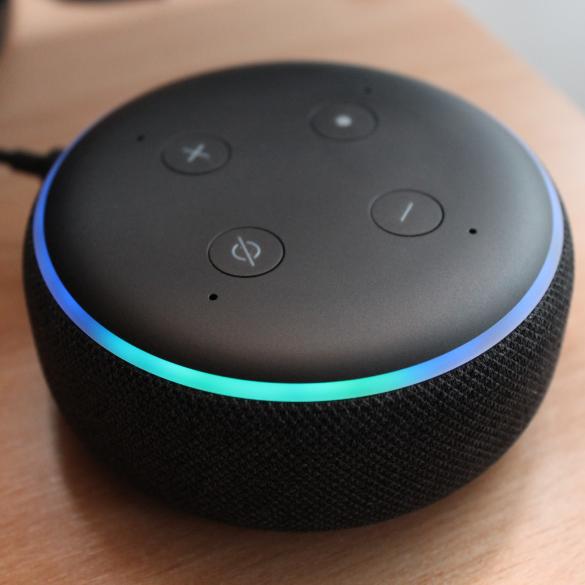The 2022 Voice Consumer Index found that 55% of people in the US use voice search when engaging in retail activities. As Jon Stine, Executive Director of the Open Voice Network, describes: “With the daily use of voice assistants rising again in the past 12 months, it’s increasingly clear that business will continue to migrate towards those firms who can speak with their customers.”
Remember how smartphone ubiquity changed how the world interacts with digital content? Voice has already begun to transform how we search, engage and shop – not to mention the meteoric rise in attention on generative AI and conversational tools like ChatGPT.
We get marketing leaders of all roles and industries asking us to start from the very beginning, so that’s what this article is for. We look at what Voice is, why your customers are bothered about it, and the top questions to ask as you begin the foray into Voice.
WHAT IS VOICE?
When we say Voice, we mean any technology using spoken commands in its interface. People can interact with the technology simply by speaking.
Getting more specific, there are three types of voice experiences:
- Voice-only: audio is the sole input and sole output. Example: an automated phone system.
- Voice-first: user’s voice is the primary, but only, input. Example: smart speakers with a display, like Amazon Echo.
- Voice-enabled: audio is an option, adding functionality. Example: using voice-to-text to send a message.
WHY DO MARKETING LEADERS CARE ABOUT VOICE?
Let’s pull out some statistics from the Voice Consumer Index 2022:
- 80% of people in the UK and US are familiar with voice technology to some extent
- Nearly a third (27%) of people in the US are using voice daily when out shopping
- 41% of people in the UK use smart speakers at home multiple times a day
- In Germany, 27% use voice in the car every day
- Mistrust in voice technology is declining as people begin to understand use cases and how their data is or isn’t shared
Aside from the results of the Voice Consumer Index 2022, there are a host of reasons why adopting voice into your marketing ecosystem might be a good idea. Beginning with accessibility: Voice can make accomplishing tasks easier for many people – including those with disabilities or access needs – not to mention the fact that it’s how we mostly communicate person-to-person anyway, so Voice is an intuitive tool to learn how to use.
Ultimately, marketing leaders should care about voice because their customers do.
WHY DO CUSTOMERS CARE ABOUT VOICE?
Put simply: because it helps them do what they want, easier and quicker.
Speaking is faster than typing. Communication that can be made audibly might be more efficient; and even if it needs writing down, the accuracy of voice recognition technology for speech-to-text has progressed rapidly over the last few years.
Speaking can be more practical than looking at a screen and typing. If someone is engaged in an activity – cooking, exercising, cleaning – they don’t have their hands free. Voice means they can undertake their original activity while also accessing information or entertainment.
Voice can also be entirely passive. From listening to podcasts to providing a reminder alert to someone who’s not near to you, voice applications can provide successful experiences even when we are not giving them 100% of our attention.
We couldn’t neglect to mention the recent level of interest in Generative AI, with ChatGPT capturing the imaginations of people across demographics. Many of your customers are interested in using innovative technologies like voice, if they’re not doing so already.
FIVE QUESTIONS TO ASK AS YOUR BUSINESS CONSIDERS VOICE
1 – What does your brand sound like?
Do you already have audio signatures (think McDonald’s I’m Lovin’ It)? If not, what preconceived ideas do your customers have of your audible brand? We cover this in a little more detail in our article Content Strategy & Voice: how to ensure a consistent brand.
2 – Is Voice an addition or an expansion?
By this we mean: will the way your customers use Voice to engage with your brand be integrated with a current channel, like an app? Or will it become a whole new channel of its own? Remember, simple voice activations can hugely benefit a customer experience, from providing alternative options, to confirming orders.
3 – Do you need a Voice strategy?
With a growth trend that surpasses mobile, it’s only natural to ask if Voice requires its own strategy. If you are already confident in the way you’re leading your suite of offerings with a user or customer-first strategy, you’re probably okay not to engage in a whole separate strategy process.
If there is one thing we learned with the evolution of the digital world, it’s that a user’s information needs don’t necessarily change because of the interface or device. The nature of their interaction, however, does change – and that is true with Voice, too.
Voice doesn’t always require a new strategy, but it does bring its own set of considerations and requirements to ensure success experience. Speaking of which…
4 – What would success look like here?
Ah, the classic business question. But not one to avoid here! What outcomes are you looking for with voice experiences: to reach more potential customers? To convert those already in your funnel? To improve the experience of buyers to boost recurrent revenue?
And perhaps even more importantly…
5 – Why would a user want this Voice experience?
As with all technology, if your application does not provide value, it will not gain traction. Just because you build something does not mean your audience will automatically seek it out, use it, or find it helpful.
It can be tempting to think that voice will automatically streamline a process or task – but that won’t happen automatically, and requires intention. Market and audience research will enable you to identify where the pain points (and therefore gains to be made) are. Find out how your products or services are discovered, engaged with, used, and returned to. These are the analytics that should form the basis of answering the question: why are we making this?
If you’re concerned that voice is adding unnecessary complexity, you can try mapping out some flowcharts. Get scrapy and sketch out where a user begins with a voice experience, where they end up, and how many steps are in between.
Feeling overwhelmed? That’s understandable. For some, Voice is a seamless addition to an already polished marketing ecosystem. For others, trial and error of different use cases is the way they learn what customers want.
Voice may be well out of the early adopter stage, but there’s still time to get ahead of the curve.
Check out what businesses like yours are using voice and conversational AI for with our case studies.





